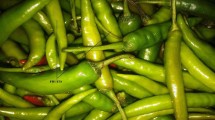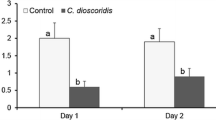Abstract
Ticks are of great economic importance to humans and animals due to their role in disease transmission. The application of synthetic, chemical acaricides on the animal and/or the environment (the most used tick control method globally) has led to the selection of tick populations that are resistant. Their adverse effects on ecology and human and animal health cannot be overemphasised. As a result, the search for alternatives that are natural and can overcome these adverse effects are strongly indicated. Using gas chromatography-mass spectrometry (GC–MS) and adult immersion test (AIT), this study evaluated the chemical composition and acaricidal activity, respectively, of Eucalyptus globulus essential oil (EO) on Rhipicephalus (Boophilus) annulatus ticks. This is a major tick species implicated for the transmission of bovine piroplasmosis in Nigeria. The acaricidal activity was evaluated using different concentrations (0.625, 1.25, 2.5, 5 and 10%) of E. globulus EO. Amitraz (1 and 2%) and cypermethrin (2%) served as the positive control and 2% dimethylsulfoxide in distilled water was the negative control. Three replicates of 10 engorged female ticks each were immersed in the test samples for 2 min and the experiment was done twice. The GC–MS analysis identified the major constituents of E. globulus EO as eucalyptol (1,8-cineole) (78%), menthol (20%) and menthone (3%). Eucalyptus globulus EO caused 97% acaricidal mortality at 10% concentration. The lower concentrations reduced tick fecundity up to 90% in a dose-dependent manner. This study provides support for plant EOs as alternative tick control strategy for humans and animals.



Similar content being viewed by others
References
Akande FA, Garba AO, Adenubi OT (2020) In vitro analysis of the efficacy of selected commercial acaricides on the cattle tick Rhipicephalus (Boophilus) annulatus (Acari: Ixodidae). Egypt J Vet Sci 51(2):153–161
Akolade JO, Olajide OO, Afolayan MO, Akande SA, Idowu DI, Orishadipe AT (2012) Chemical composition, antioxidant and cytotoxic effects of Eucalyptus globulus grown in north-central Nigeria. J Nat Prod Plant Res 2(1):1–8
Alvarez A, Saez JM, Costa JSD, Colin VL, Fuentes MS, Cuozzo SA, Amoroso MJ (2017) Actinobacteria: current research and perspectives for bioremediation of pesticides and heavy metals. Chemosphere 166:41–62
Atmani-Merabet G, Belkhiri A, Dems MA, Lalaouna A, Khalfaoui Z, Mosbah B (2018) Chemical composition, toxicity and acaricidal activity of Eucalyptus globulus essential oil from Algeria. Curr Issues Pharm Med Sci 31(2):89–93
Badawy ME, El-Arami SA, Abdelgaleil SA (2010) Acaricidal and quantitative structure activity relationship of monoterpenes against the two-spotted spider mite Tetranychus urticae. Exp Appl Acarol 52(3):261–274
Barbosa LCA, Filomeno CA, Teixeira RR (2016) Chemical variability and biological activities of Eucalyptus spp. essential oils. Molecules 21(12):1671. https://doi.org/10.3390/molecules21121671
Betancourt-Cravioto M, Falcón-Lezama JA, Tapia-Conyer R (2017) Roadmap for the introduction of a new Dengue vaccine. In: Speranza MA (ed) Dengue: immunopathology and control strategies, pp 125–140
Bhat MH, Jain AK, Fayaz M (2018) Indian herbal drug industry: challenges and prospects. In: Ozturk M, Hakeem K (eds) Plant and human health. Springer, Cham, pp 657–673
Bipin K, Ray J, Goyal P, Aggarwal K (2015) Approach of Eucalyptus globulus plant parts for human health safety and toxicological aspects. Br Open J Plant Sci 1(1):1–10
Camilo CJ, Alves Nonato CDF, Galvão-Rodrigues FF, Costa WD, Clemente GG, Macedo S, Custódio MA, Rodrigues G, Fernandes F, da Costa JGM (2017) Acaricidal activity of essential oils: a review. Trends Phytochem Res 1(4):183–198
Chagas ACS, Passos WM, Prates HT, Leite RC, Furlong J, Fortes ICP (2002) Acaricidal effect of essential oils and concentrates emulsification of Eucalyptus spp. in Boophilus microplus. Braz J Vet Res An Sci 39:247–253
Dehghani-Samani A, Madreseh-Ghahfarokhi S, Dehghani-Samani A (2015) Acaricidal and repellent activities of essential oil of Eucalyptus globulus against Dermanyssus gallinae (Acari: Mesostigmata). J Herbmed Pharmacol 4:81–84
De Meneghi D, Stachurski F, Adakal H (2016) Experiences in tick control by acaricide in the traditional cattle sector in Zambia and Burkina Faso: possible environmental and public health implications. Public Health Front 4:239–249
Derwich E, Benziane Z, Boukir A (2009) GC/MS analysis of volatile constituents and antibacterial activity of the essential oil of the leaves of Eucalyptus globulus in Atlas Median from Morocco. Adv Nat Appl Sci 3(3):305–314
Djebir S, Ksouri S, Trigui M, Tounsi S, Boumaaza A, Hadef Y, Benakhla A (2019) Chemical composition and acaricidal activity of the essential oils of some plant species of Lamiaceae and Myrtaceae against the vector of tropical bovine theileriosis: Hyalomma scupense (syn. Hyalomma detritum). Biomed Res Int. https://doi.org/10.1155/2019/7805467
Elyemni M, Louaste B, Nechad I, Elkamli T, Bouia A, Taleb M, Chaoush M, Eloutassi N (2019) Extraction of essential oils of Rosmarinus officinalis L. by two different methods: hydrodistillation and microwave assisted hydrodistillation. Sci World J. https://doi.org/10.1155/2019/3659432
Ekhuemelo DO, Onah G, Wuam L (2017) Evaluation of the uses of Eucalyptus species in Makurdi Local Government Area of Benue State, Nigeria. GSC Biol Pharm Sci 1(1):25–34
Failloux AB, Moutailler S (2015) Zoonotic aspects of vector-borne infections. Rev Sci Technol 34(1):175–183
Food and Agriculture Organisation (2004) Module 1: ticks: Acaricide resistance: diagnosis, management and prevention, pp 25–77
Greay TL, Oskam CL, Gofton AW, Rees RL, Ryan UM, Irwin PJ (2016) A survey of ticks (Acari: Ixodidae) of companion animals in Australia. Parasit Vectors 9(1):207–217
Hurtado OJB, Giraldo-Ríos C (2018) Economic and health impact of the ticks in production animals. Ticks and tick-borne pathogens. Intech Open. https://doi.org/10.5772/intechopen.81167
Hussein H, Reda A, Momen F (2013) Repellent, antifeedent and toxic effects of three essential oils on the two spotted spider mite, Tetranychus urticae Koch (Acari: Tetranychidae). Acta Phytopathol Entomol Hung 48(1):177–186
Immediato D, Figueredo LA, Iatta R, Camarda A, de Luna RLN, Giangaspero A, Brandão-Filho SP, Otranto D, Cafarchia C (2016) Essential oils and Beauveria bassiana against Dermanyssus gallinae (Acari: Dermanyssidae): towards new natural acaricides. Vet Parasitol 229:159–165
Isman MB, Machial CM (2006) Pesticides based on plant essential oils: from traditional practice to commercialization. Adv Phytomed 3:29–44
Karemu CK, Ndung’u MW, Githua M (2013) Repellent effects of essential oils from selected Eucalyptus species and their major constituents against Sitophilus zeamais (Coleoptera: Curculionidae). Int J Trop Insect Sci 33(3):188–194
Klafke GM, Miller RJ, Tidwell J, Barreto R, Guerrero FD, Kaufman PE, Pérez de León AA (2017) Mutation in the sodium channel gene corresponds with phenotypic resistance of Rhipicephalus sanguineus sensu lato (Acari: Ixodidae) to pyrethroids. J Med Entomol 54:1639–1642
Lawal-Adebowale OA (2012) Factors influencing small ruminant production in selected urban communities of Abeokuta. Ogun State Niger J Anim Prod 39(1):218–228
Li G, Lou HX (2018) Strategies to diversify natural products for drug discovery. Med Res Rev 38(4):1255–1294
Lieberman HR (1983) Computation of psychophysical thresholds using the probit technique. Behav Res Methods Instrum 15(4):446–448
Lorusso V, Picozzi K, de Bronsvoort BM, Majekodunmi A, Dongkum C, Balak G, Welburn SC (2013) Ixodid ticks of traditionally managed cattle in central Nigeria: where Rhipicephalus (Boophilus) microplus does not dare (yet?). Parasit Vectors 6(1):171–181
Lucia A, Licastro S, Zerba E, Audino PG, Masuh H (2009) Sensitivity of Aedes aegypti adults (Diptera: Culicidae) to the vapours of Eucalyptus essential oils. Bioresour Technol 100(23):6083–6087
Madreseh-Ghahfarokhi S, Dehghani-Samani A, Pirali Y (2019) Zingiber officinalis and Eucalyptus globulus, potent lethal/repellent agents against Rhipicephalus bursa, probable carrier for zoonosis. J Arthropod-Borne Dis 13:214–223
Marcic D (2012) Acaricides in modern management of plant-feeding mites. J Pest Sci 85(4):395–408
Mawalagedera SM, Symonds MR, Callahan DL, Gaskett AC, Rønsted N (2019) Combining evolutionary inference and metabolomics to identify plants with medicinal potential. Front Ecol Evol 7:267. https://doi.org/10.3389/fevo.2019.00267
Mossi AJ, Astolfi V, Kubiak G, Lerin L, Zanella C, Toniazzo G, de Oliveira D, Treichel H, Devilla IA, Cansiana R, Restello R (2011) Insecticidal and repellency activity of essential oil of Eucalyptus sp. against Sitophilus zeamais Motschulsky (Coleoptera, Curculionidae). J Sci Food Agric 91(2):273–277
Ogden NH, Lindsay LR (2016) Effects of climate and climate change on vectors and vector-borne diseases: ticks are different. Trends Parasitol 32(8):646–656
Opara M, Maxwell NE (2012) Ixodid ticks of cattle in Borno and Yobe states in North eastern Nigeria: breed and coat colour preference. Anim Res Int 8(1):1359–1365
Pamo ET, Tendonkeng F, Kana JR, Payne VK, Boukila B, Lemoufouet J, Nanda AS (2005) A study of the acaricidal properties of an essential oil extracted from the leaves of Ageratum houstonianum. Vet Parasitol 128:3–4
Pirali-Kheirabadi K, Razzaghi-Abyaneh M, Halajian A (2009) Acaricidal effect of Pelargonium roseum and Eucalyptus globulus essential oils against adult stage of Rhipicephalus (Boophilus) annulatus in vitro. Vet Parasitol 162(3–4):346–349
Prates HT, Santos JP, Waquil JM, Fabris JD, Oliveira AB, Foster JE (1998) Insecticidal activity of monoterpenes against Rhyzopertha dominica (F.) a Tribolium castaneum (Herbst). J Stored Prod Res 34:243–249
Regnault-Roger C, Vincent C, Arnason JT (2012) Essential oils in insect control: low-risk products in a high-stakes world. Ann Rev Entomol 57:405–424
Roh HS, Lee BH, Park CG (2013) Acaricidal and repellent effects of myrtacean essential oils and their major constituents against Tetranychus urticae (Tetranychidae). J Asia Pac Entomol 16(3):245–249
Rossi YE, Palacios SM (2015) Insecticidal toxicity of Eucalyptus cinerea essential oil and 1,8-cineole against Musca domestica and possible uses according to the metabolic response of flies. Ind Crop Prod 63:133–137
Thorsell W, Mikiver A, Tunon H (2006) Repelling properties of some plant materials on the tick Ixodes ricinus L. Phytomed 13:132–134
Vuong QV, Chalmers AC, Jyoti Bhuyan D, Bowyer MC, Scarlett CJ (2015) Botanical, phytochemical and anticancer properties of the Eucalyptus species. Chem Biodivers 12(6):907–924
Walker AR (2003) Ticks of domestic animals in Africa: a guide to identification of species. Bioscience Reports, Edinburgh, pp 3–210
Yang YC, Choi HY, Choi WS, Clark JM, Ahn YJ (2004) Ovicidal and adulticidal activity of Eucalyptus globulus leaf oil terpenoids against Pediculus humanus capitis (Anoplura: Pediculidae). J Agric Food Chem 52(9):2507–2511
Funding
The research was done by personal funding.
Author information
Authors and Affiliations
Contributions
OTA designed the experiment and wrote the manuscript, AOA and TS carried out the experiment and data analysis, FAA contributed to data analysis and finalizing the manuscript and HL did the EO and GC–MS analysis.
Corresponding author
Ethics declarations
Conflict of interest
The authors declare no competing interests.
Consent for publication
All authors gave their consent for publication.
Additional information
Publisher's Note
Springer Nature remains neutral with regard to jurisdictional claims in published maps and institutional affiliations.
Rights and permissions
About this article
Cite this article
Adenubi, O.T., Abolaji, A.O., Salihu, T. et al. Chemical composition and acaricidal activity of Eucalyptus globulus essential oil against the vector of tropical bovine piroplasmosis, Rhipicephalus (Boophilus) annulatus. Exp Appl Acarol 83, 301–312 (2021). https://doi.org/10.1007/s10493-020-00578-z
Received:
Accepted:
Published:
Issue Date:
DOI: https://doi.org/10.1007/s10493-020-00578-z




